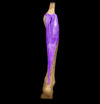Chapter 10: Muscular System Flashcards
(121 cards)
Functions of Muscles
Movement Stability Control of openings and passageways Heat
Thin sleeve of loose connective tissue surrounding each muscle fiber that allows room for capillaries and nerve fibers to reach each muscle fiber?
Endomysium
A slightly thicker layer of connective tissue that contains fascicles that carry larger nerves and blood vessels, and stretch receptors.
Perimysium
Fibrous sheath surrounding the entire muscle. The outer surface grades into the fascia and the inner surface sends projections between fascicles to form Perimysium.
Epimysium
Sheet of connective tissue that separates neighboring muscles or muscle groups from each other and the subcutaneous tissue.
Fascia
Muscles that are thick in the middle and tapered at the ends such as the biceps brachii and gastrocnemius.
Fusiform muscles
Muscles that have uniform width and parallel fascicles that can span long distances such as the rectus abdominis and the zygomaticus major.
Parallel muscles
Fan shaped muscles such as the pectoralis major and the temporalis.
Triangular or convergent muscles
Feather shaped muscles that have fascicles that insert obliquely on a tendon such as the rectus femoris and deltoid. These muscles can be unipennate, bipennate, or multipennate.
Pennate muscles
Muscles that have a ring around a body opening such as the orbicularis oculi and the urethral and anal sphincters.
Circular muscles or sphincters
Three kinds of muscle tissue?
Skeletal Cardiac Smooth
Tendons bridge the gap between muscle ends and bony attachment and the collagen fibers of the -endo, peri-, and epimysium continue into the tendon from there into the periosteum and the matrix of bones not what type of attachment?
Indirect attachment
Tendon that is a broad, flat sheet such as the rectus sheath.
Aponeurosis
Tendons bridge the gap between muscle ends and bony attachment and the collagen fibers of the endo-, peri-, and epimysium continue into the tendon from there into the periosteum and the matrix of bone in what type of muscle attachment?
indirect muscle attachment
What muscle is this?

Frontalis
What muscle is this?

Orbicularis oculi
What muscle is this?

Orbicularis oris
What muscle is this?

Zygomaticus major
What muscle is this?

Zygomaticus minor
What muscle is this?

Buccinator
What muscle is this?

Platysma
To open the mouth
depression
Biting and grinding
elevation
Using the incisors to cut
protraction
















































































